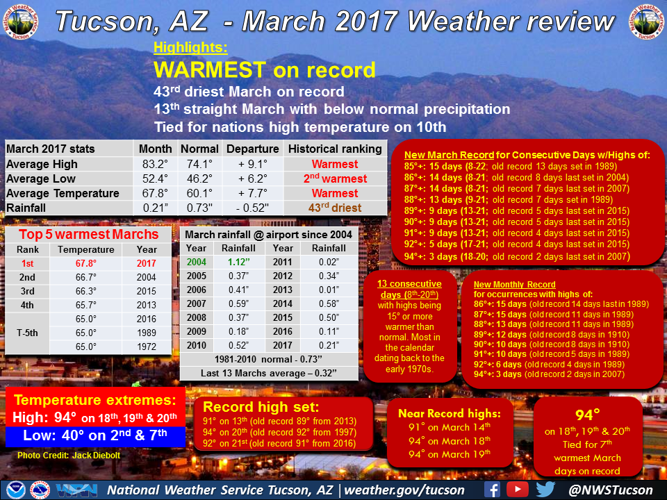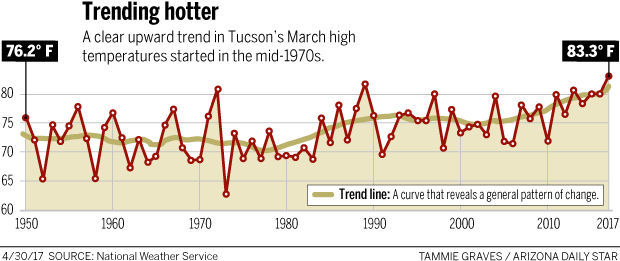Human-caused climate change was at least partly to blame and probably mostly to blame for Tucson’s record-setting March heat, says a researcher with expertise in this field.
At the Star’s request, researcher Geert Jan van Oldenborgh of the Netherlands analyzed possible factors for explaining Tucson’s March temperatures, which averaged nearly 8 degrees above normal overall when daytime highs and nighttime lows are accounted for.
He concluded that long-term temperature trends point almost certainly to human-caused greenhouse-gas emissions as a factor. The unresolved question, he said, is how big of a factor they are.
That longer-term increase was more than 7 degrees Fahrenheit in average high temperatures since about 1950, said van Oldenborgh. He’s a senior researcher for the Royal Netherlands Meteorological Institute, the country’s equivalent of the U.S.’s National Weather Service.
That is a much faster increase than has occurred globally, he said.
Van Oldenborgh’s analysis illustrates a new trend in climate-change research: showing that human-produced greenhouse-gas emissions cause extreme weather events. For a long time, many climate scientists said it’s not possible to attribute such events to long-term climate change. But a U.S. National Academy of Sciences study released last summer concluded that such attribution is possible if done in a scientifically valid manner.
Van Oldenborgh’s analysis wasn’t a formal, peer-reviewed study. But, “I can tell you unequivocally that he used methodologies that the National Academy of Sciences committee agreed were appropriate,” said Kathy Jacobs, a University of Arizona specialist in climate change adaptation who, like van Oldenborgh, sat on the academy committee that produced the 2016 report.
She said evidence of global warming is “incredibly clear across Southern Arizona, and it is undoubtedly a contributing factor in the heat wave in March.”
Jacobs, who led the publication of the federal government’s 2014 National Climate Assessment, now directs the UA’s Center for Climate Adaptation and Solutions.
7 degrees warmer since 1950
Tucson’s March weather was very warm both by day and at night. But high daytime temperatures were a bigger factor, National Weather Service records show.
The month’s average high temperature of 83.2 degrees was 9.1 degrees hotter than normal. It was the warmest on record for March. The average low of 52.4 degrees was 6.2 degrees above normal and was the second warmest on record for March. The weather service has kept records here since 1895.
More strikingly, March 2017 had 15 consecutive days where the high reached at least 85 degrees. That’s two days more than the previous record for such temperatures, set in March 1989.
The temperature was at least 91 degrees for nine consecutive days this March, compared to the previous record of four, in 2015. The high hit 94 degrees for three straight days this March, compared to the previous record of two, in 2007.
In his analysis, van Oldenborgh found that a clear upward trend in the March high temperatures started in the middle 1970s. The mean high temperature has grown by about 4 degrees Celsius, or 7.2 degrees Fahrenheit, since around 1950. That first raised a suspicion in him that perhaps other forces besides global warming were playing a role, he said.
“Whenever there is extreme weather, the question is raised whether it was due to external influences such as greenhouse gases or variations of solar activity,” van Oldenborgh said. “Local influences such as irrigation, urban effects and the decreasing snow cover in the mountains in March can also play a role.
“Extreme weather always has a large element of chance due to the random weather, but the external factors may have shifted the odds,” said van Oldenborgh, who has collaborated with other scientists in publishing 16 papers on the extreme weather-climate change connection since 2012 and has submitted eight more for publication. Most recently, he and other scientists affiliated with a group called World Weather Attribution published a study saying climate change tripled the likelihood of February’s unusual warmth nationally that made it the second-warmest February on record in the United States.
Tucson warming faster
than surrounding cities
Looking across Southern and Central Arizona high temperatures for March, van Oldenborgh found they seem to be warming across the region but that Tucson’s temperatures are rising faster than in nearby cities Casa Grande and Willcox.
The urban heat-island effect often accounts for differing temperatures between larger and smaller cities. But van Oldenborgh said he tried to account for such differences by focusing his analysis on daytime high temperatures, not nighttime lows that are most commonly affected by the heat island effect.
He then looked at two computer models that simulated this city’s long-term temperature trends and potential impacts on those temperatures.
One, of higher resolution, showed that March high temperatures have risen at a point near Tucson at about 2.5 times the rate the global average temperature has risen since about 1950, he said. The model shows that is the local effect of global warming, he said.
Without the impacts of human-caused forces, “there is no trend,” Oldenborgh concluded. Solar and volcanic forces can’t explain this region’s warming; nor can decade-long temperature variability produced by the ocean, he said.
But a second set of climate models, used by the Intergovernmental Panel on Climate Change in 2013, showed that Tucson has received on average less long-term warming than shown by the first model.
The second model also contained a large uncertainty as to the cause of the lesser warming, meaning that some of the cause could have been natural, year-to-year temperature variability, van Oldenborgh said.
He said he believes the higher-resolution computer model pointing mostly to climate change as a driving factor is more reliable for the purpose of this analysis. He said he believes the IPCC models probably underestimate the long-term temperature trend.





